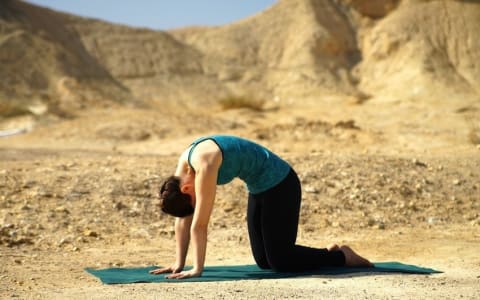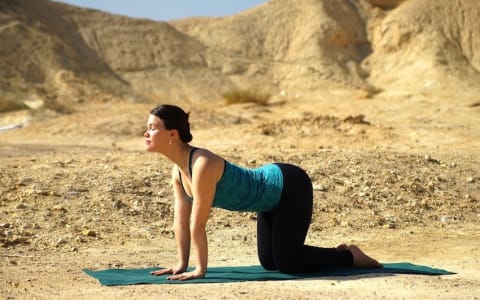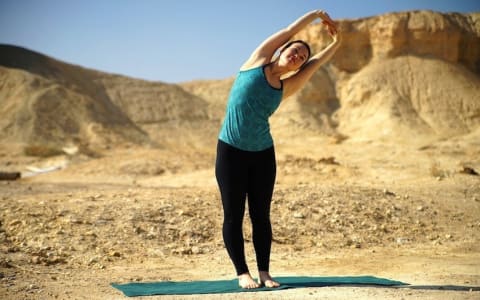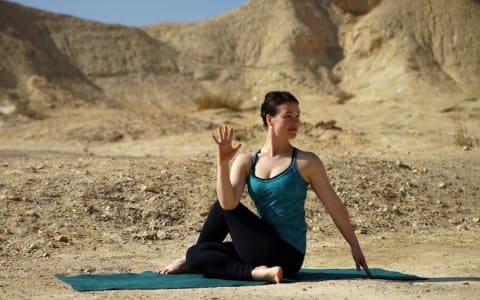The spine is made up of four curves. The cervical spine is the topmost curve. It is comprised of seven vertebrae in the neck. Below it, the 12 thoracic vertebrae form the curve to which the ribs attach. The low back, or lumbar curve, is made up of five vertebrae, the largest bodied vertebrae of the spine. And the bottommost curve is comprised of five fused vertebrae in the sacrum followed by four fused vertebrae in the coccyx. This bottommost curve of the spine joins with the pelvis and serves as the back of the pelvic bowl. In Cat Pose, hands and knees are on the mat with shoulders stacked above wrists and hips over knees. As you press down into your arms and legs and hollow out the front of your body, the spine rounds into flexion. Here, the bellybutton hugs up to the spine, the tailbone drops down, and the chin draws into the chest. The flexion in Cat Pose occurs as the thoracic curve deepens its natural convexity (also known as kyphosis), though this range of motion is partially limited in the top thoracic vertebrae to reduce interference with respiration. Additionally, the shapes of the cervical and lumbar vertebrae allow the neck and low back join in flexion. Cow Pose, a counter pose to Cat, exercises extension of the spine. As you turn your pelvis forward, lift your sit bones, soften your middle and lower back toward the floor, and open your collarbones and throat toward the front of your mat. The extension in Cow Pose is achieved as the lumbar and cervical spines deepen into their natural concavity (also known as lordosis). Though the shape of the thoracic vertebrae do not allow for as much extension in the thoracic spine, it’s important to energetically spread the extension through the length of the spine so that the pressure of extension does not compound only in the lower back. For many, the thoracic spine may feel immobile, but thoracic extension is possible to a small degree. In Crescent Moon, the pelvis and legs anchor into the earth through parallel feet, and the trunk of the body assumes a C-shaped curve to the side. Counterbalance the lean of your lateral flexion by energetically committing weight into your opposite foot. Lateral flexion is achieved with great freedom in the cervical and lumbar spinal curves, and to a lesser degree in the thoracic spine, as side bending is partially limited by the resistance of the rib cage and sternum. Half Lord of the Fishes pose is a seated twist for the spine. From a seated position with your legs extended forward, step one foot across your opposite knee and bend your bottom leg to tuck your foot near your opposite hip. Root down into your sit bones to lengthen your spine upward. At your tallest, twist toward your top leg. Hug your front leg or pin your elbow across your thigh. The rotation of this pose is achieved in the thoracic and cervical spines, as the shape of the lumbar vertebrae allow for limited rotation in order to preserve stability. Begin twisting from behind the bellybutton, and allow the twist to spiral up your spine until at last the head turns with the chin parallel to the floor.






